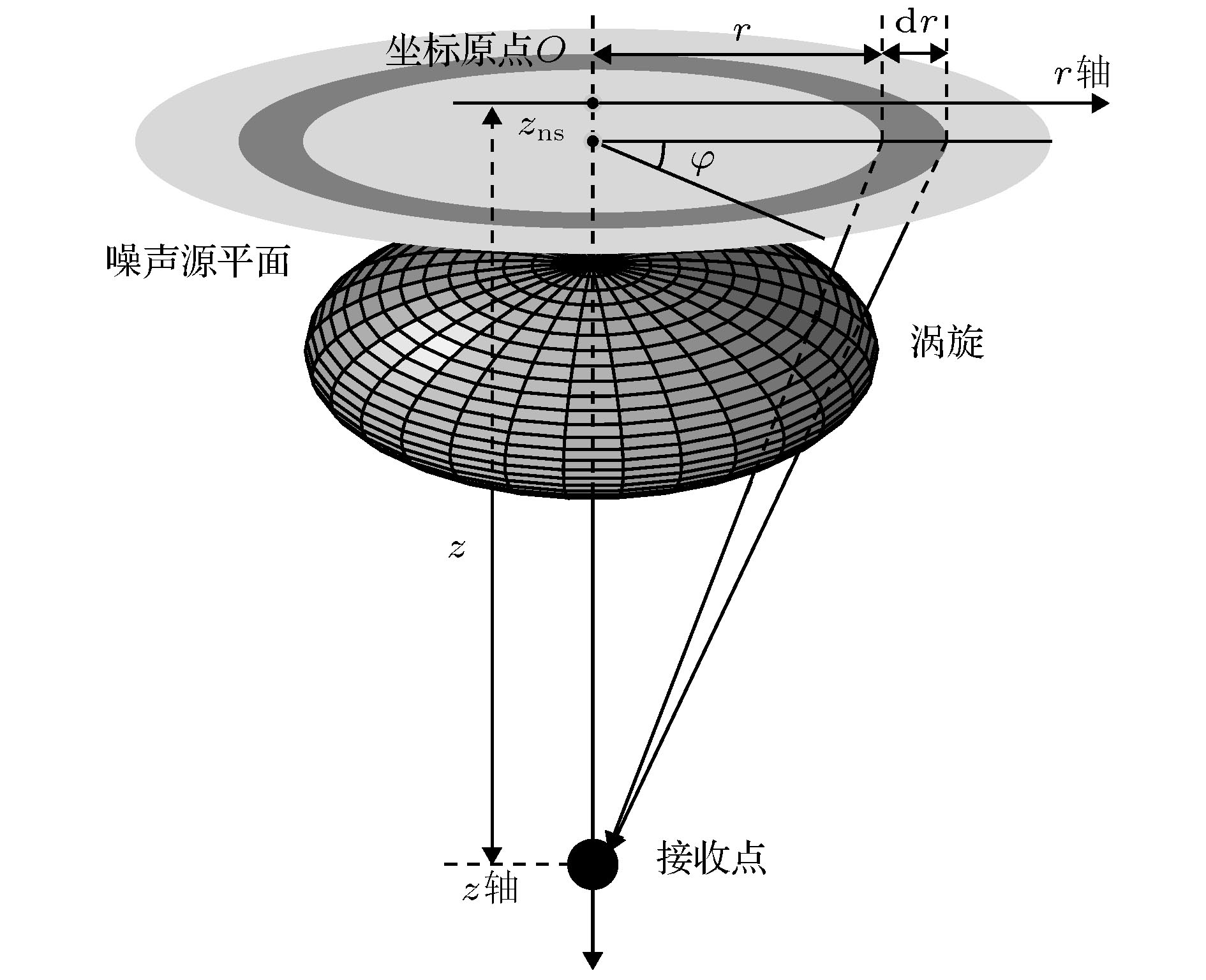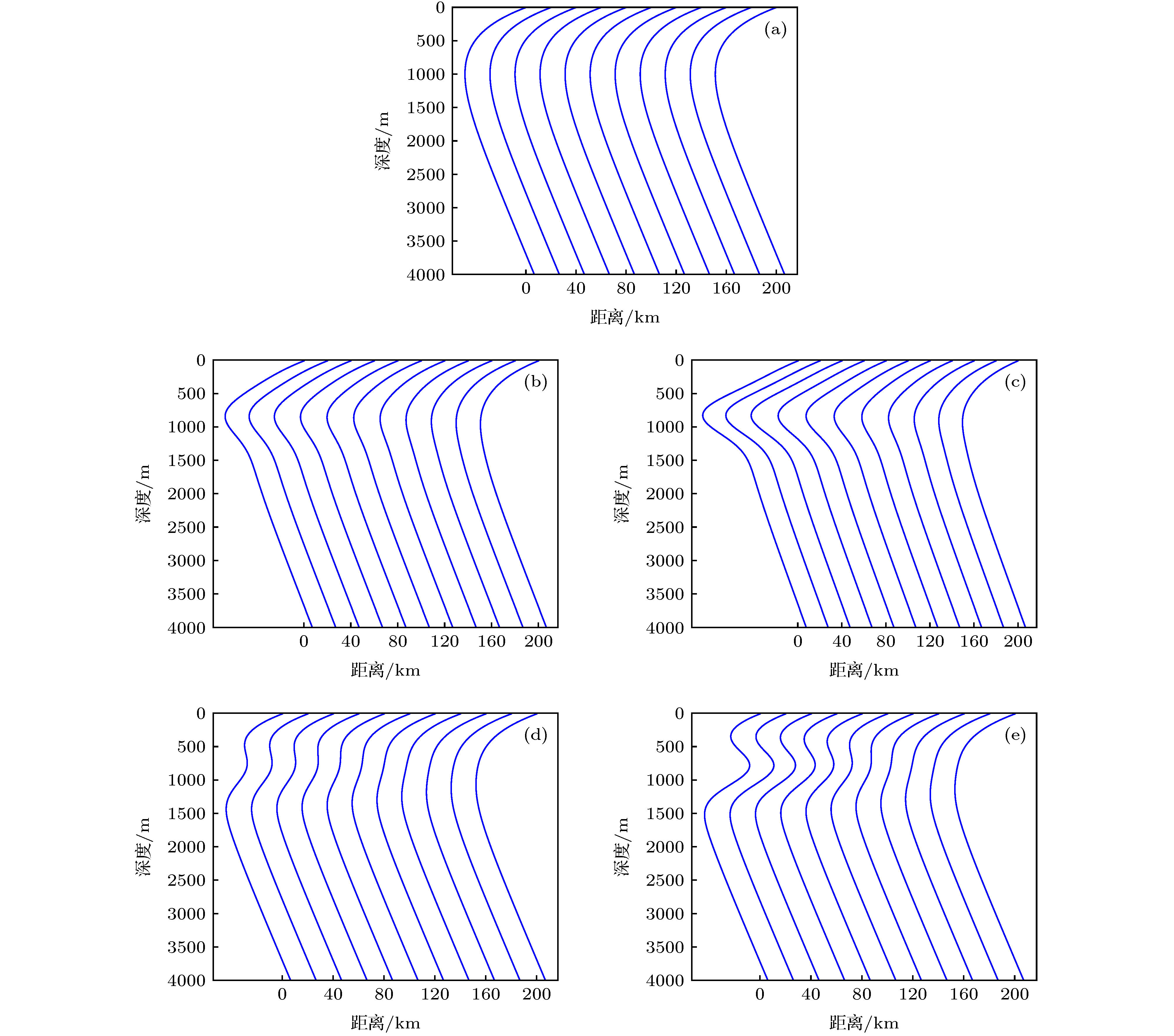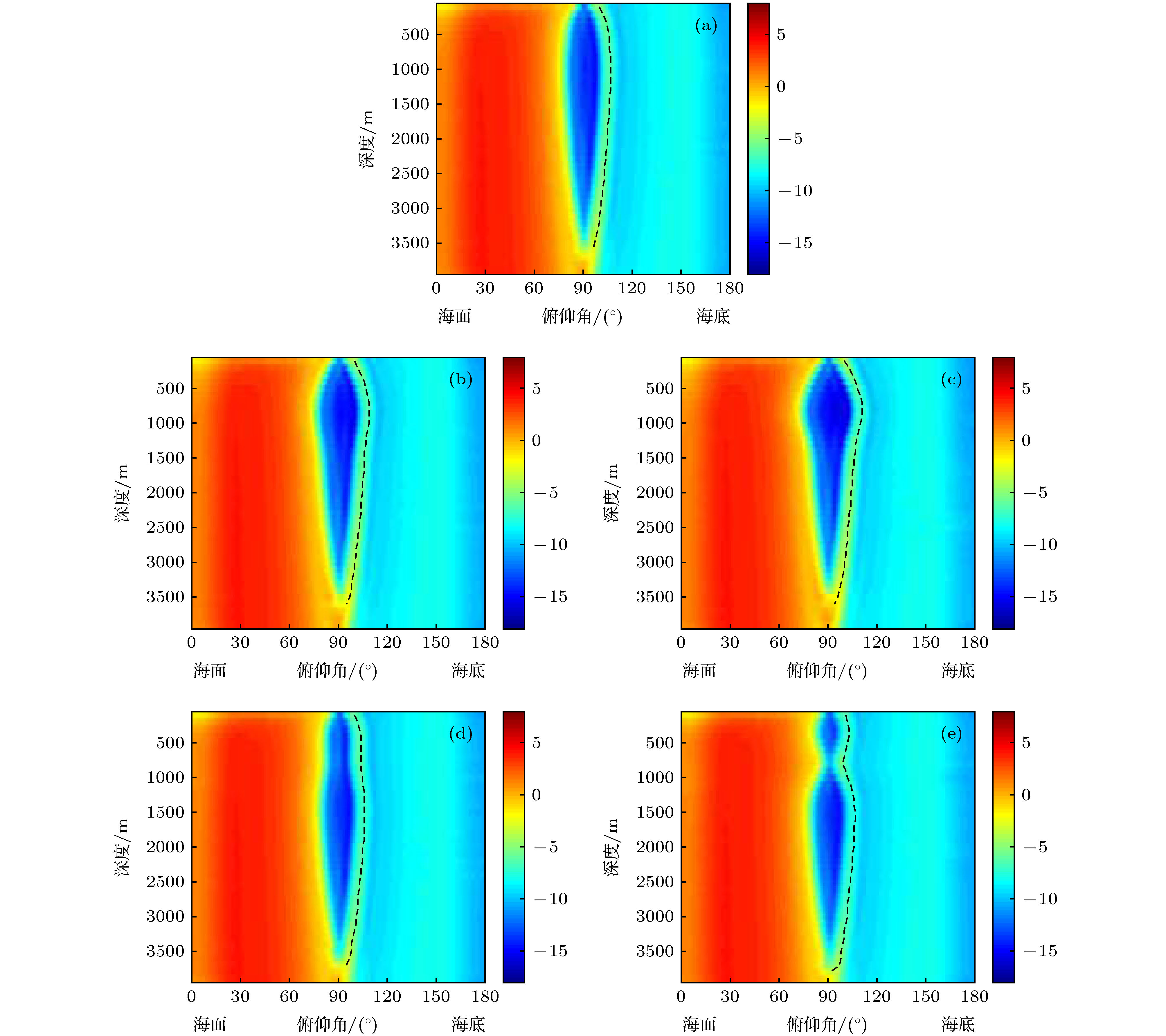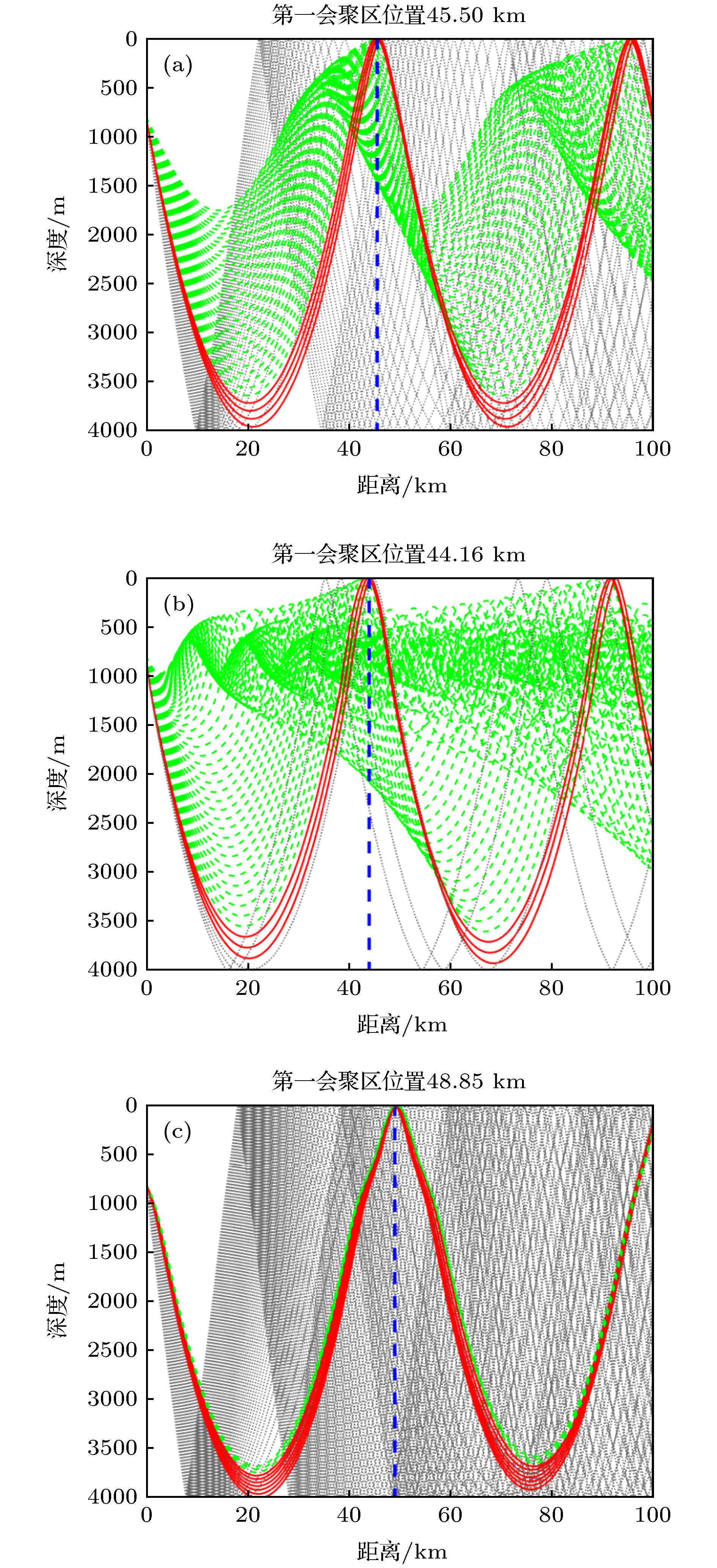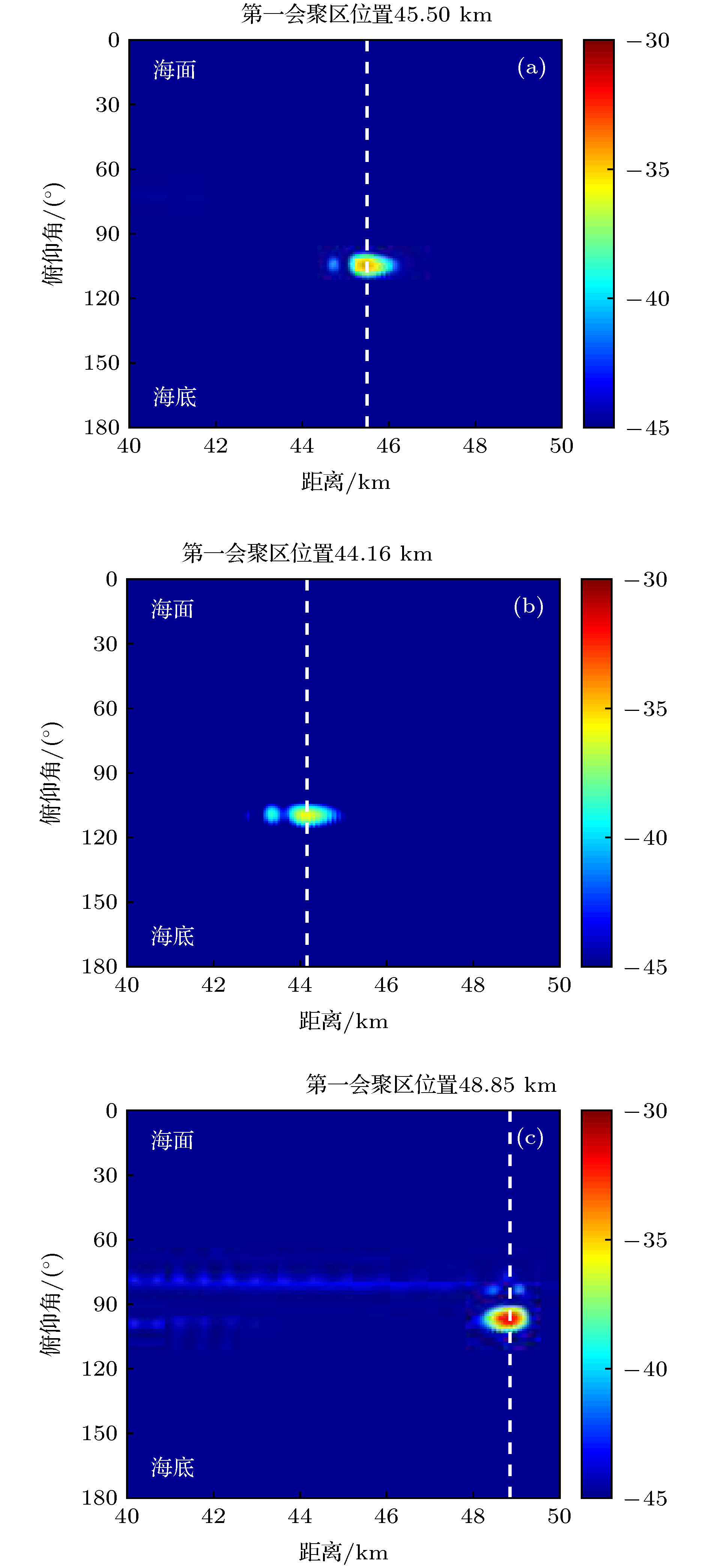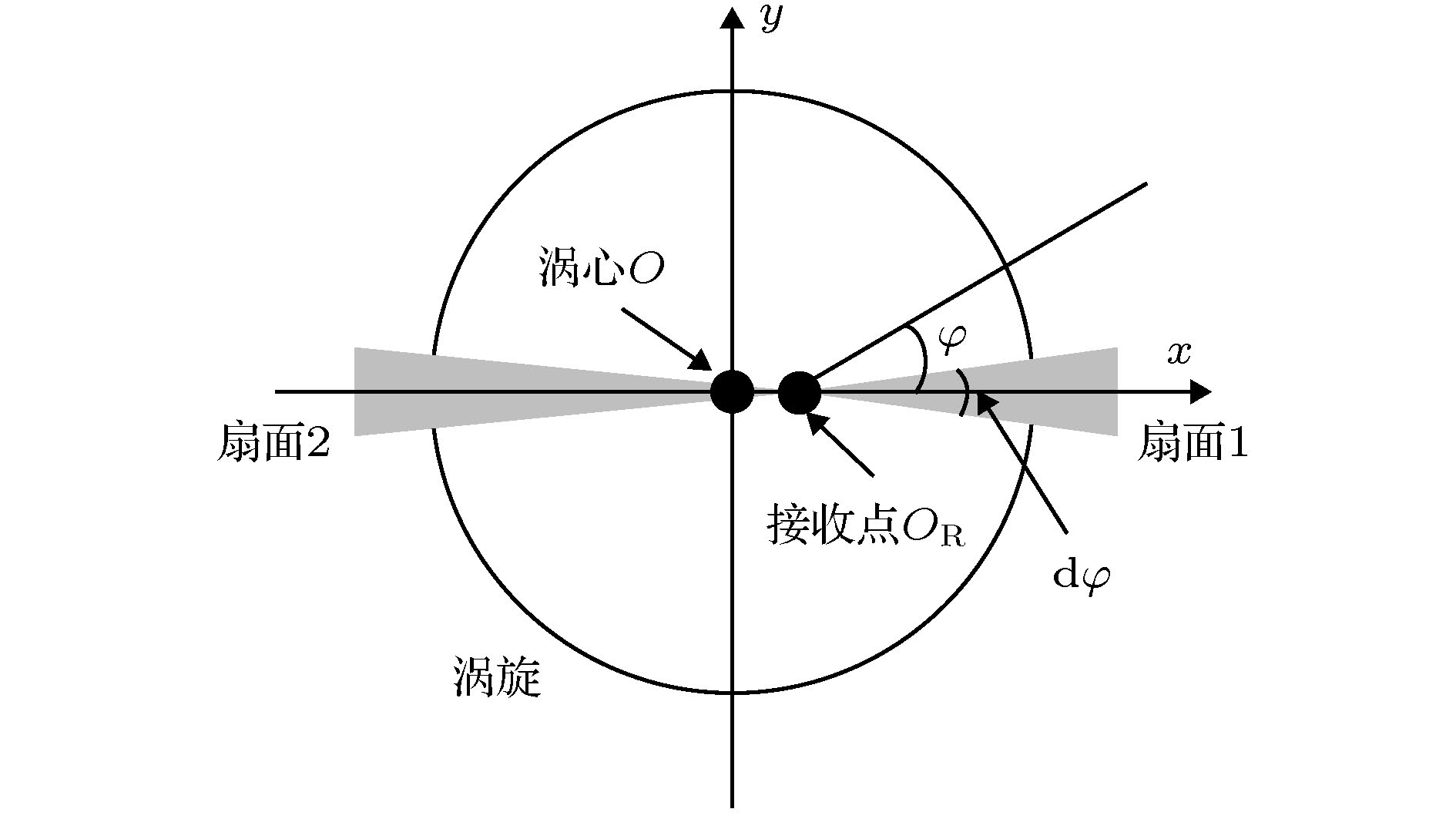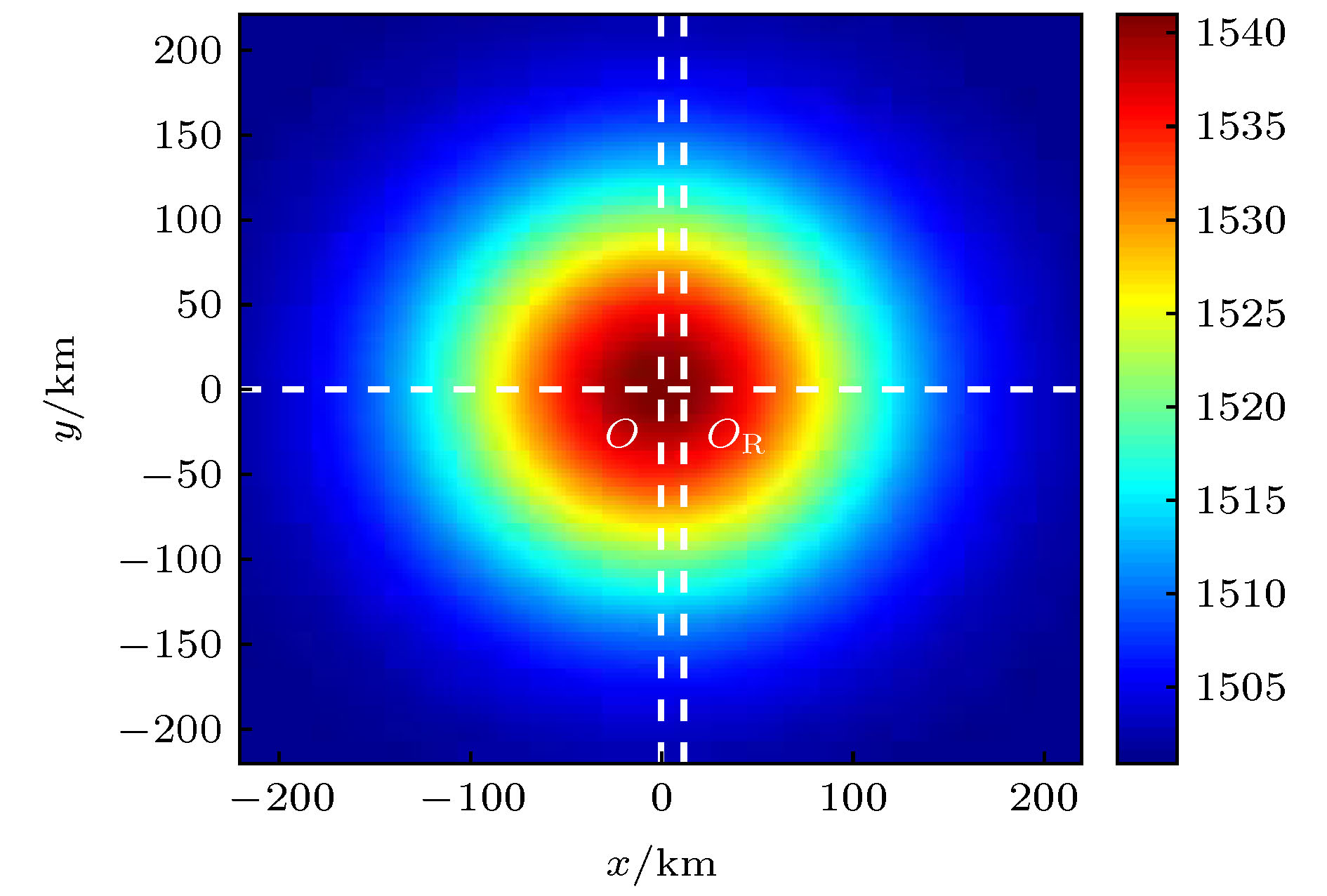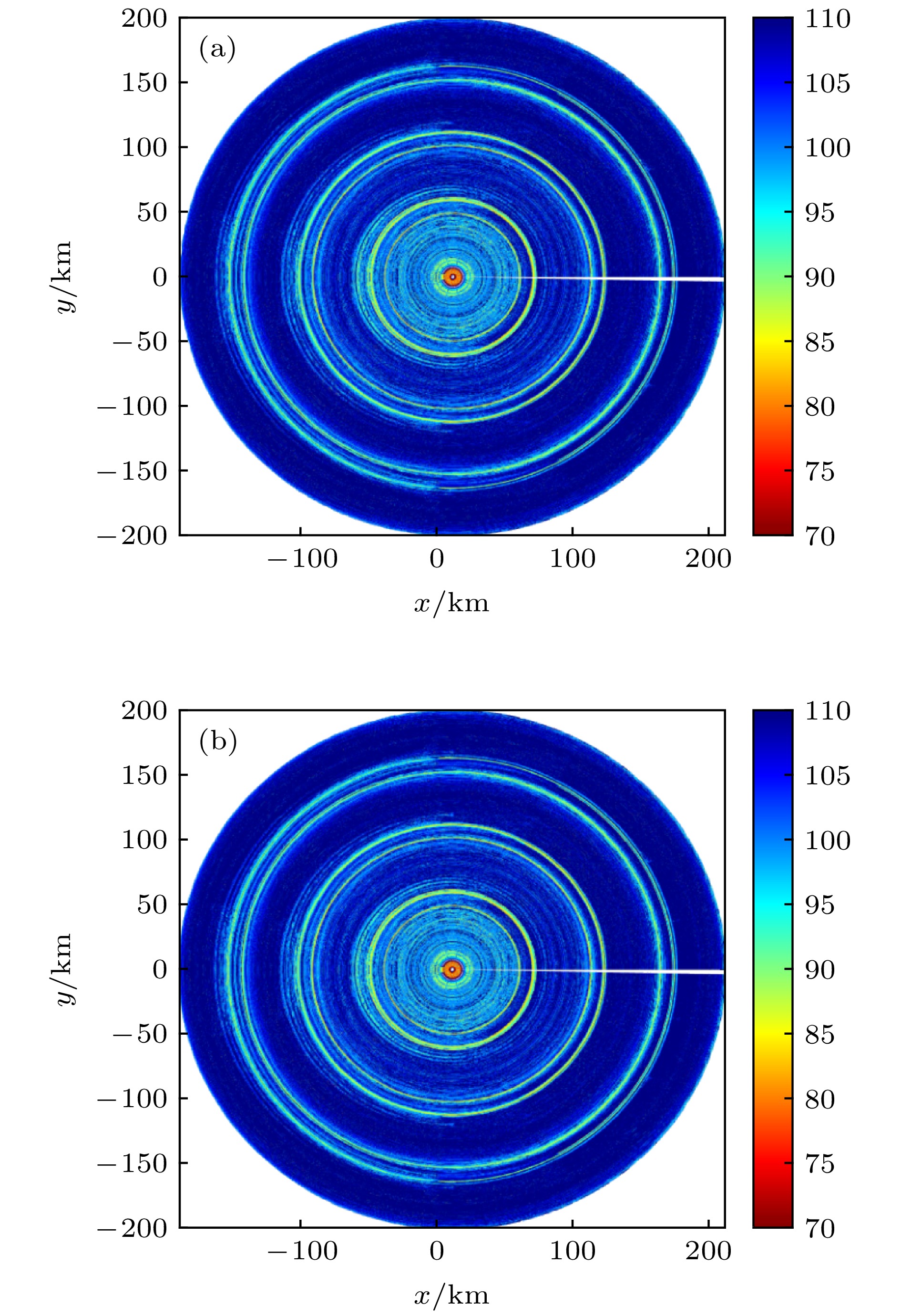-
涡旋是深海环境中频繁出现的海洋现象, 它会引起上层海水的声速扰动, 改变海面风成噪声的传播过程, 最终导致噪声场特性异常. 本文采用高斯涡模型描述涡旋引起的声速扰动, 分别使用射线和抛物方程模型描述近场和远场噪声信号的传播, 研究了涡旋对其水平中心位置不同深度上的风成噪声垂直空间特性(包括噪声垂直方向性和垂直相关性)的影响. 研究表明: 1)在涡心深度上, 涡旋对噪声垂直空间特性的影响最大, 其中冷涡导致噪声垂直方向性中水平凹槽的宽度增加, 凹槽下边缘峰值的高度降低, 噪声垂直相关性减弱, 暖涡的影响反之; 2)在远离涡心的深度上, 涡旋对噪声垂直空间特性的影响减小, 冷涡和暖涡分别仅引起噪声垂直方向性中水平凹槽下边缘峰值的高度升高和降低, 对噪声垂直相关性几乎没有影响; 3)涡旋对噪声垂直空间特性的影响均随其绝对强度增大而增强. 针对以上现象, 使用射线逆推方法分析了涡旋影响噪声垂直空间特性的机理. 该方法由噪声接收点发射声线, 利用声场互易性分析噪声沿声线反向到达接收点的俯仰角和能量大小. 分析表明, 存在涡旋时, 噪声沿海面反射声线反向到达接收点的俯仰角和能量变化, 是引起噪声垂直空间特性变化的主要原因. 此外, 仿真表明, 当接收点偏离涡旋水平中心但两者距离较近时, 研究中的分析和结论仍是近似成立的.Mesoscale eddy is a marine phenomenon occurring frequently in deep ocean, and it will disturb the sound speed in the upper water layer. As a result, the mesoscale eddies will influence the propagation of wing-generated noise and cause the noise field to vary. In this paper, we investigate the effects of mesoscale eddies on the vertical spatial characteristics (including the noise vertical directionality and the noise vertical correlation) of wind-generated noise at different depths of its horizontal center of the eddy. In the study, the Gaussian eddy model is used to describe the sound speed fluctuation, and the ray and parabolic equation theories are used to describe the noise propagating in the near field and far field, respectively. Simulations indicate as follows. 1) At the depth of the eddy center, a clod-core eddy causes both the width of the horizontal notch and the noise vertical correlation to decrease, while the effect of a warm-core eddy is contrary to that of the cold-core eddy. 2) At the depth far from the eddy center, the effect of eddies is reduced, a cold-core and a warm-core eddy only lead the peak at the down edge of the horizontal notch in the noise directionality to rise and fall, respectively, and do not influence the noise vertical correlation. 3) The effect of an eddy becomes severe as its absolute strength becomes higher. The ray reversion method based on the principle of reciprocity is used to explain the physical reason behind the above phenomena. By the method the rays are launched from the noise receiving point and the polar angle and the strength of the noise arriving reversely along the ray paths are analyzed. It is shown that the change of the polar angle and the strength of the noise arriving reversely along the surface reflected ray paths in the presence of eddies are the main cause for changing the noise vertical spatial characteristics. Furthermore, simulations show that the analyses and conclusions in the study are still approximately valid when the receiving point deviates from the eddy center but the horizontal distance between them is short.
-
Keywords:
- eddy /
- wind-generated noise /
- vertical directionality /
- vertical correlation /
- ray model /
- parabolic equation model
[1] Carey W M, Evans R B 2011 Ocean Ambient Noise (New York: Springer) pp62−68
[2] Wenz G M 1962 J. Acoust. Soc. Am. 34 1936
 Google Scholar
Google Scholar
[3] Yang T C, Yoo K 1997 J. Acoust. Soc. Am. 101 2541
 Google Scholar
Google Scholar
[4] 蒋光禹, 孙超, 刘雄厚, 谢磊 2019 物理学报 68 024302
 Google Scholar
Google Scholar
Jiang G Y, Sun C, Xie L, Liu X H 2019 Acta Phys. Sin. 68 024302
 Google Scholar
Google Scholar
[5] Yoo K, Yang T C 1998 J. Acoust. Soc. Am. 104 3326
 Google Scholar
Google Scholar
[6] Harrison C H 2018 J. Acoust. Soc. Am. 143 1689
 Google Scholar
Google Scholar
[7] Buckingham M J, Jones S A 1987 J. Acoust. Soc. Am. 81 938
 Google Scholar
Google Scholar
[8] Harrison C H, Simons D G 2002 J. Acoust. Soc. Am. 112 1377
 Google Scholar
Google Scholar
[9] Roux P, Kuperman W A, Group N 2004 J. Acoust. Soc. Am. 116 1995
 Google Scholar
Google Scholar
[10] Sabra K G, Roux P, Kuperman W A 2005 J. Acoust. Soc. Am. 117 164
 Google Scholar
Google Scholar
[11] Buckingham M J 2011 J. Acoust. Soc. Am. 129 3562
 Google Scholar
Google Scholar
[12] Etter P C 2018 Underwater Acoustic Modeling and Simulation (3rd Ed.) (New York: CRC Press) pp214−231, 188−190
[13] Cron B F, Sherman C H 1962 J. Acoust. Soc. Am. 34 1732
 Google Scholar
Google Scholar
[14] Kuperman W A, Ingentio F 1980 J. Acoust. Soc. Am. 67 1988
 Google Scholar
Google Scholar
[15] Liggett W S, Jacobson M J 1965 J. Acoust. Soc. Am. 38 303
 Google Scholar
Google Scholar
[16] Harrison C H 1997 Appl. Acoust. 51 289
 Google Scholar
Google Scholar
[17] Carey W M, Evans R B, Davis J A, Botseas G 1990 IEEE J. Oceanic Eng. 15 324
 Google Scholar
Google Scholar
[18] Perkins J S, Kuperman W A, Ingentio F, Fialkowski L T 1993 J. Acoust. Soc. Am. 93 739
 Google Scholar
Google Scholar
[19] Hamson R M 1985 J. Acoust. Soc. Am. 78 1702
 Google Scholar
Google Scholar
[20] Deane G B, Buckingham M J, Tindle C T 1997 J. Acoust. Soc. Am. 102 3413
 Google Scholar
Google Scholar
[21] Harison C H 1997 J. Acoust. Soc. Am. 102 2655
 Google Scholar
Google Scholar
[22] Buckingham M J 2013 J. Acoust. Soc. Am. 134 950
 Google Scholar
Google Scholar
[23] 刘伯胜, 雷家煜 2010 水声学原理第二版 (哈尔滨: 哈尔滨工程大学出版社) 第23−30页
Liu B S, Lei J Y 2010 Principle of Underwater Acoustics 2nd (Harbin: Harbin Engineering University Press) pp23−30 (in Chinese)
[24] Urick R J 1975 J. Acoust. Soc. Am. 5 8
[25] Rouseff D, Tang D J 2006 J. Acoust. Soc. Am. 120 1284
 Google Scholar
Google Scholar
[26] 江鹏飞, 林建恒, 马力, 蒋国健 2013 声学学报 38 724
Jiang P F, Lin J H, Ma L, Jiang G J 2013 Acta Acustica 38 724
[27] 汤博 2019 博士学位论文 (北京: 中国科学院大学)
Tang B 2019 Ph. D. Dissertation (Beijing: University of Chinese Academy Sciences) (in Chinese)
[28] Weinberg N L, Clark J G 1980 J. Acoust. Soc. Am. 68 703
 Google Scholar
Google Scholar
[29] Baer R N 1980 J. Acoust. Soc. Am. 67 1180
 Google Scholar
Google Scholar
[30] Lawrence M W 1983 J. Acoust. Soc. Am. 73 474
 Google Scholar
Google Scholar
[31] Henrick R F, Burkom H S 1983 J. Acoust. Soc. Am. 73 173
 Google Scholar
Google Scholar
[32] Jian Y J, Zhang J, Liu S Q, Wang Y F 2009 Appl. Acoust. 70 432
 Google Scholar
Google Scholar
[33] Heaney K D, Campbell R L 2016 J. Acoust. Soc. Am. 139 918
 Google Scholar
Google Scholar
[34] 李佳迅, 张韧, 陈奕德, 金宝刚 2011 海洋通报 30 37
 Google Scholar
Google Scholar
Li J X, Zhang R, Chen Y D, Jin B G 2011 Marin. Sci. Bull. 30 37
 Google Scholar
Google Scholar
[35] Xiao Y, Li Z L, Li J, Liu J Q, Sabra K G 2019 Chin. Phys. B 28 054301
 Google Scholar
Google Scholar
[36] Chen C, Jin T, Zhou Z Q 2019 Appl. Acoust. 150 190
 Google Scholar
Google Scholar
[37] Chen C, Gao Y, Yan F G, Zhou Z Q 2019 Acoust. Aust. 47 185
 Google Scholar
Google Scholar
[38] 康颖 2014 硕士学位论文 (青岛: 中国海洋大学)
Kang Y 2004 M.S. Thesis (Qingdao: Ocean University of China) (in Chinese)
[39] Jesen F B, Kuperman W A, Porter M B, Schmidt H Computational Ocean Acoustics 2nd (Berlin: Springer Science Business Media) pp155−230, 457−527
[40] Munk W H 1974 J. Acoust. Soc. Am. 55 220
 Google Scholar
Google Scholar
[41] Poter M B https://oalib-acoustics.org/Rays/HLS-2010-1.pdf [2020-4-17]
[42] Collins M D https://oalib-acoustics.org/PE/RAM/ram.pdf [2020-4-17]
[43] Collins M D 1993 J. Acoust. Soc. Am. 93 1736
 Google Scholar
Google Scholar
[44] Collins M D 1994 J. Acoust. Soc. Am. 96 382
 Google Scholar
Google Scholar
[45] Cox H 1973 J. Acoust. Soc. Am. 54 1289
 Google Scholar
Google Scholar
[46] Poter M B https://oalib-acoustics.org/AcousticsToolbox/Kraken.pdf [2020-4-17]
[47] 周建波 2018 博士学位论文 (哈尔滨: 哈尔滨工程大学)
Zhou J B 2018 Ph. D. Dissertation (Harbin: Harbin Engineering University) (in Chinese)
[48] Brekhovskikh L M, Lysanov Y P, Beyer R T 2003 Fundamentals of Ocean Acoustics (3rd Ed.) (New York: Springer) pp50−52
-
图 4 涡旋强度
$ D_{\rm c} $ 不同值时的声速分布 (a)$ D_{\rm c}=0 $ ; (b)$ D_{\rm c}=-20 $ ; (c)$ D_{\rm c}=-40 $ ; (d)$ D_{\rm c}=20 $ ; (e)$ D_{\rm c}=40 $ Fig. 4. Sound speed distribution with different
$ D_{\rm c} $ : (a)$ D_{\rm c}=0 $ ; (b)$ D_{\rm c}=-20 $ ; (c)$ D_{\rm c}=-40 $ ; (d)$ D_{\rm c}=20 $ ; (e)$ D_{\rm c}=40 $ 图 5 涡旋强度
$ D_{\rm c} $ 取不同值时, 不同深度上的噪声垂直方向性 (图中黑色虚线指示了水平凹槽下边缘峰值) (a)$ D_{\rm c}=0 $ ; (b)$ D_{\rm c}=-20 $ ; (c)$ D_{\rm c}=-40 $ ; (d)$ D_{\rm c}=20 $ ; (e)$ D_{\rm c}=40 $ Fig. 5. Noise vertical directionalities at different depths with different
$ D_{\rm c} $ (black dashed line in each subfigure indicates the location of the peak at the downward edge of the horizontal notch): (a)$ D_{\rm c}=0 $ ; (b)$ D_{\rm c}=-20 $ ; (c)$ D_{\rm c}=-40 $ ; (d)$ D_{\rm c}=20 $ ; (e)$ D_{\rm c}=40 $ 图 7 800 m深度上, 涡旋强度
$ D_{\rm c} $ 取不同值时的噪声垂直相关函数 (a)$ {\rm Re}\left[ \varGamma(d) \right] $ ; (b)$ {\rm{Im}}\left[ \varGamma(d) \right] $ Fig. 7. Noise vertical correlation functions with different
$ D_{\rm c} $ at 800 m depth: (a)$ {\rm Re}\left[ \varGamma(d) \right] $ ; (b)$ {\rm{Im}}\left[ \varGamma(d) \right] $ 图 8 2000 m深度上, 涡旋强度
$ D_{\rm c} $ 取不同值时的噪声垂直相关函数 (a)$ {\rm Re}\left[ \varGamma(d) \right] $ ; (b)$ {\rm{Im}}\left[ \varGamma(d) \right] $ Fig. 8. Noise vertical correlation functions with different
$ D_{\rm c} $ at 2000 m depth: (a)$ {\rm Re}\left[ \varGamma(d) \right] $ ; (b)$ {\rm{Im}}\left[ \varGamma(d) \right] $ 图 9
$ D_{\rm c} $ 取0,$ -40 $ 和40时, 以(0, 800 m)为发射点, 出射俯仰角为$95.5 ^\circ — 110.5 ^\circ$ 的声线轨迹图(图中绿色虚线、红色实线和灰色点线分别表示NR, SR和SRBR声线) (a)$ D_{\rm c}= $ 0; (b)$ D_{\rm c}=-40 $ ; (c)$ D_{\rm c}=40 $ Fig. 9. Traces of the rays launching from the (0, 800 m) point with the launching polar angles varying within
$95.5 ^\circ - 110.5 ^\circ$ under the conditions where$ D_{\rm c} $ equals to 0,$ -40 $ , and 40 (green dashed lines, red solid lines and gray dotted lines in each subfigure indicate the NR, SR, and SRBR rays, respectively): (a)$ D_{\rm c} \!=\! $ 0; (b)$ D_{\rm c}\!=\! -40 $ ; (c)$ D_{\rm c}\!=\! 40$ 图 10
$ D_{\rm c} $ 取0,$ -40 $ 和40时, 40—50 km不同$ {\rm d}r $ 范围内的噪声源产生的噪声场在800 m深度上的垂直方向性$ B_r(\theta) $ (a)$ D_{\rm c}=0 $ ; (b)$ D_{\rm c}=-40 $ ; (c)$ D_{\rm c}=40 $ Fig. 10. Noise vertical noise directionalities
$ B_r(\theta) $ generated by noise sources within$ {\rm d}r $ at 800 m depth with r varying from 40 to 50 km under the conditions where$ D_{\rm c} $ equals to 0,$ -40 $ , and 40: (a)$ D_{\rm c}=0 $ ; (b)$ D_{\rm c}=-40 $ ; (c)$ D_{\rm c}=40 $ 图 11
$ D_{\rm c} $ 取0,$ -40 $ 和40时, 以(0, 2000 m)为发射点, 出射俯仰角为$95.5 ^\circ — 110.5 ^\circ$ 的声线轨迹图(图中绿色虚线、红色实线和灰色点线分别表示NR, SR和SRBR声线) (a)$ D_{\rm c}=0 $ ; (b)$ D_{\rm c}=-40 $ ; (c)$ D_{\rm c}=40 $ Fig. 11. Traces of the rays launching from the (0, 2000 m) point with the launching polar angles varying within
$95.5 ^\circ - 110.5 ^\circ$ under the conditions where$ D_{\rm c} $ equals to 0,$ -40 $ , and 40 (green dashed lines, red solid lines and gray dotted lines in each subfigure indicate the NR, SR, and SRBR rays, respectively): (a)$ D_{\rm c}=0 $ ; (b)$ D_{\rm c}=-40 $ ; (c) Dc = 40图 12
$ D_{\rm c} $ 取0,$ -40 $ 和40时, 40—50 km不同$ {\rm d}r $ 范围内的噪声源产生的噪声场在2000 m深度上的垂直方向性$ B_r(\theta) $ (a)$ D_{\rm c}=0 $ ; (b)$ D_{\rm c}=-40 $ ; (c)$ D_{\rm c}=40 $ Fig. 12. Noise vertical noise directionalities
$ B_r(\theta) $ generated by noise sources within$ {\rm d}r $ at 2000 m depth with r varying from 40 to 50 km under the conditions where$ D_{\rm c} $ equals to 0,$ -40 $ , and 40: (a)$ D_{\rm c}=0 $ ; (b)$ D_{\rm c}=-40 $ ; (c)$ D_{\rm c}=40 $ 图 15 使用Bellhop3D, 分别选择
${{N}} \times {\rm{2 D}}$ 和$ \rm 3 D $ 模式计算得到的$ O_{\rm R} $ 处800 m深度上的声源到噪声源深度(0.5 m)水平截面的传播损失 (a)${{N}} \times {\rm{2 D}}$ ; (b)${\rm{3 D}}$ Fig. 15. Transmission loss from
$ O_{\rm R} $ 800 m depth to the noise sources depth (0.5 m) cross section computed by the Bellhop3D program in${{N}} \times {\rm{2D}}$ and 3D modes: (a) N × 2D; (b) 3D表 1
$ D_{\rm c} $ 取0,$ -40 $ 和40时, 以(0, 800 m)为发射点, 出射俯仰角大于$90 ^\circ$ 的声线中, SR声线的最小出射俯仰角$ \theta_{{\rm{SR}}, {\rm{min}}} $ 、最大出射俯仰角$\theta_{{\rm{SR}}, {\rm{max}}}$ 、中心出射俯仰角$\theta_{{\rm{SR}}, {\rm{c}}}$ 和出射俯仰角宽度$ \Delta \theta_{\rm{SR}} $ Table 1. Minimal lunching polar angle
$\theta_{{\rm{SR}}, {\rm{min}}}$ , maximal launching polar angle$\theta_{{\rm{SR}}, {\rm{max}}}$ , central launching polar angle$\theta_{{\rm{SR}}, {\rm{c}}}$ , and launching polar angle width$ \Delta \theta_{\rm{SR}} $ of the SR rays launching from the (0, 800 m) point with the launching polar angle being greater than$90 ^\circ$ under the conditions where$ D_{\rm c} $ equals to 0,$ -40 $ , and 40$ D_{\rm c} $ $\theta_{{\rm{SR} }, {\rm{min} }}$ $\theta_{{\rm{SR} }, {\rm{max} }}$ $\theta_{{\rm{SR} }, {\rm{c} }}$ $ \Delta \theta_{\rm{SR}} $ 0 104.3° 105.1° 104.70° 0.8° –40 109.3° 110.0° 109.65° 0.7° 40 96.3° 97.7° 97.00° 1.4° 表 2
$ D_{\rm c} $ 取0,$ -40 $ 和40时, 以(0, 2000 m)为发射点, 出射俯仰角大于$90 ^\circ$ 的声线中, SR声线的最小出射俯仰角$\theta_{{\rm{SR}}, {\rm{min}}}$ 、最大出射俯仰角$\theta_{{\rm{SR}}, {\rm{max}}}$ 、中心出射俯仰角$\theta_{{\rm{SR}}, {\rm{c}}}$ 和出射俯仰角宽度$ \Delta \theta_{\rm{SR}} $ Table 2. Minimal launching polar angle
$\theta_{{\rm{SR}}, {\rm{min}}}$ , maximal launching polar angle$\theta_{{\rm{SR}}, {\rm{max}}}$ , central launching polar angle$\theta_{{\rm{SR}}, {\rm{c}}}$ , and launching polar angle width$ \Delta \theta_{\rm{SR}} $ of the SR rays launching from the (0, 2000 m) point with the launching polar angle being greater than$90 ^\circ$ under the conditions where$ D_{\rm c} $ equals to 0,$ -40 $ , and 40$ D_{\rm c} $ $\theta_{{\rm{SR} }, {\rm{min} }}$ $\theta_{{\rm{SR} }, {\rm{max} }}$ $\theta_{{\rm{SR} }, {\rm{c} }}$ $ \Delta \theta_{\rm{SR}} $ 0 102.3° 103.4° 102.85° 1.1° –40 102.0° 103.4° 102.70° 1.4° 40 102.7° 103.4° 103.05° 0.7° -
[1] Carey W M, Evans R B 2011 Ocean Ambient Noise (New York: Springer) pp62−68
[2] Wenz G M 1962 J. Acoust. Soc. Am. 34 1936
 Google Scholar
Google Scholar
[3] Yang T C, Yoo K 1997 J. Acoust. Soc. Am. 101 2541
 Google Scholar
Google Scholar
[4] 蒋光禹, 孙超, 刘雄厚, 谢磊 2019 物理学报 68 024302
 Google Scholar
Google Scholar
Jiang G Y, Sun C, Xie L, Liu X H 2019 Acta Phys. Sin. 68 024302
 Google Scholar
Google Scholar
[5] Yoo K, Yang T C 1998 J. Acoust. Soc. Am. 104 3326
 Google Scholar
Google Scholar
[6] Harrison C H 2018 J. Acoust. Soc. Am. 143 1689
 Google Scholar
Google Scholar
[7] Buckingham M J, Jones S A 1987 J. Acoust. Soc. Am. 81 938
 Google Scholar
Google Scholar
[8] Harrison C H, Simons D G 2002 J. Acoust. Soc. Am. 112 1377
 Google Scholar
Google Scholar
[9] Roux P, Kuperman W A, Group N 2004 J. Acoust. Soc. Am. 116 1995
 Google Scholar
Google Scholar
[10] Sabra K G, Roux P, Kuperman W A 2005 J. Acoust. Soc. Am. 117 164
 Google Scholar
Google Scholar
[11] Buckingham M J 2011 J. Acoust. Soc. Am. 129 3562
 Google Scholar
Google Scholar
[12] Etter P C 2018 Underwater Acoustic Modeling and Simulation (3rd Ed.) (New York: CRC Press) pp214−231, 188−190
[13] Cron B F, Sherman C H 1962 J. Acoust. Soc. Am. 34 1732
 Google Scholar
Google Scholar
[14] Kuperman W A, Ingentio F 1980 J. Acoust. Soc. Am. 67 1988
 Google Scholar
Google Scholar
[15] Liggett W S, Jacobson M J 1965 J. Acoust. Soc. Am. 38 303
 Google Scholar
Google Scholar
[16] Harrison C H 1997 Appl. Acoust. 51 289
 Google Scholar
Google Scholar
[17] Carey W M, Evans R B, Davis J A, Botseas G 1990 IEEE J. Oceanic Eng. 15 324
 Google Scholar
Google Scholar
[18] Perkins J S, Kuperman W A, Ingentio F, Fialkowski L T 1993 J. Acoust. Soc. Am. 93 739
 Google Scholar
Google Scholar
[19] Hamson R M 1985 J. Acoust. Soc. Am. 78 1702
 Google Scholar
Google Scholar
[20] Deane G B, Buckingham M J, Tindle C T 1997 J. Acoust. Soc. Am. 102 3413
 Google Scholar
Google Scholar
[21] Harison C H 1997 J. Acoust. Soc. Am. 102 2655
 Google Scholar
Google Scholar
[22] Buckingham M J 2013 J. Acoust. Soc. Am. 134 950
 Google Scholar
Google Scholar
[23] 刘伯胜, 雷家煜 2010 水声学原理第二版 (哈尔滨: 哈尔滨工程大学出版社) 第23−30页
Liu B S, Lei J Y 2010 Principle of Underwater Acoustics 2nd (Harbin: Harbin Engineering University Press) pp23−30 (in Chinese)
[24] Urick R J 1975 J. Acoust. Soc. Am. 5 8
[25] Rouseff D, Tang D J 2006 J. Acoust. Soc. Am. 120 1284
 Google Scholar
Google Scholar
[26] 江鹏飞, 林建恒, 马力, 蒋国健 2013 声学学报 38 724
Jiang P F, Lin J H, Ma L, Jiang G J 2013 Acta Acustica 38 724
[27] 汤博 2019 博士学位论文 (北京: 中国科学院大学)
Tang B 2019 Ph. D. Dissertation (Beijing: University of Chinese Academy Sciences) (in Chinese)
[28] Weinberg N L, Clark J G 1980 J. Acoust. Soc. Am. 68 703
 Google Scholar
Google Scholar
[29] Baer R N 1980 J. Acoust. Soc. Am. 67 1180
 Google Scholar
Google Scholar
[30] Lawrence M W 1983 J. Acoust. Soc. Am. 73 474
 Google Scholar
Google Scholar
[31] Henrick R F, Burkom H S 1983 J. Acoust. Soc. Am. 73 173
 Google Scholar
Google Scholar
[32] Jian Y J, Zhang J, Liu S Q, Wang Y F 2009 Appl. Acoust. 70 432
 Google Scholar
Google Scholar
[33] Heaney K D, Campbell R L 2016 J. Acoust. Soc. Am. 139 918
 Google Scholar
Google Scholar
[34] 李佳迅, 张韧, 陈奕德, 金宝刚 2011 海洋通报 30 37
 Google Scholar
Google Scholar
Li J X, Zhang R, Chen Y D, Jin B G 2011 Marin. Sci. Bull. 30 37
 Google Scholar
Google Scholar
[35] Xiao Y, Li Z L, Li J, Liu J Q, Sabra K G 2019 Chin. Phys. B 28 054301
 Google Scholar
Google Scholar
[36] Chen C, Jin T, Zhou Z Q 2019 Appl. Acoust. 150 190
 Google Scholar
Google Scholar
[37] Chen C, Gao Y, Yan F G, Zhou Z Q 2019 Acoust. Aust. 47 185
 Google Scholar
Google Scholar
[38] 康颖 2014 硕士学位论文 (青岛: 中国海洋大学)
Kang Y 2004 M.S. Thesis (Qingdao: Ocean University of China) (in Chinese)
[39] Jesen F B, Kuperman W A, Porter M B, Schmidt H Computational Ocean Acoustics 2nd (Berlin: Springer Science Business Media) pp155−230, 457−527
[40] Munk W H 1974 J. Acoust. Soc. Am. 55 220
 Google Scholar
Google Scholar
[41] Poter M B https://oalib-acoustics.org/Rays/HLS-2010-1.pdf [2020-4-17]
[42] Collins M D https://oalib-acoustics.org/PE/RAM/ram.pdf [2020-4-17]
[43] Collins M D 1993 J. Acoust. Soc. Am. 93 1736
 Google Scholar
Google Scholar
[44] Collins M D 1994 J. Acoust. Soc. Am. 96 382
 Google Scholar
Google Scholar
[45] Cox H 1973 J. Acoust. Soc. Am. 54 1289
 Google Scholar
Google Scholar
[46] Poter M B https://oalib-acoustics.org/AcousticsToolbox/Kraken.pdf [2020-4-17]
[47] 周建波 2018 博士学位论文 (哈尔滨: 哈尔滨工程大学)
Zhou J B 2018 Ph. D. Dissertation (Harbin: Harbin Engineering University) (in Chinese)
[48] Brekhovskikh L M, Lysanov Y P, Beyer R T 2003 Fundamentals of Ocean Acoustics (3rd Ed.) (New York: Springer) pp50−52
计量
- 文章访问数: 8797
- PDF下载量: 97
- 被引次数: 0













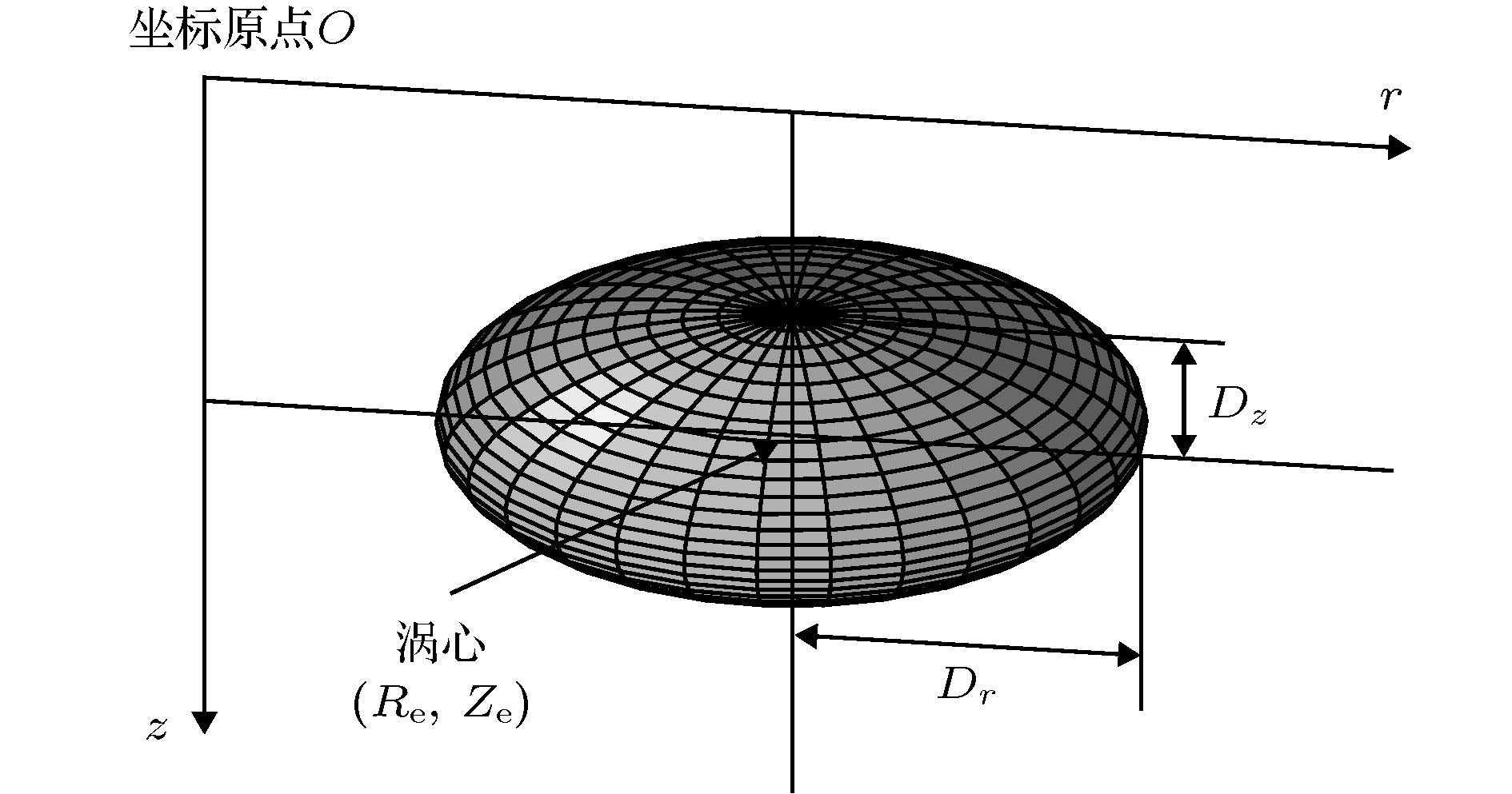
 下载:
下载:
